Investing in Old Stock Certificates
by Bob Brooke
QUESTION:
I’ve been unpacking some old boxes of things left
to me by my father. In one of them I discovered some old stock
certificates. Are they worthless or do they have investment
value?
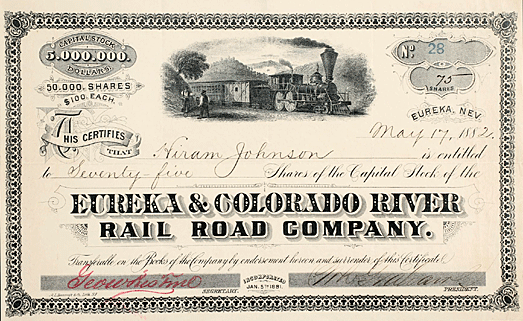
Thanks,
Charles
_________________________________________________________
ANSWER:
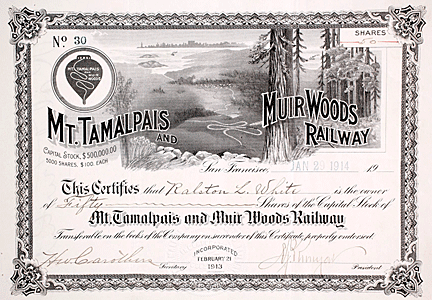 Old
stock certificates, especially those from defunct companies, are only
worth the paper that they’re printed on. But some, especially those with
signatures from famous people, famous companies, or those involved in
major scandals, can be worth quite a bit. Old
stock certificates, especially those from defunct companies, are only
worth the paper that they’re printed on. But some, especially those with
signatures from famous people, famous companies, or those involved in
major scandals, can be worth quite a bit.
What exactly is a stock certificate? A stock certificate is the physical
piece of paper representing ownership in a company and includes the
number of shares owned, the date, an identification number, usually a
corporate seal, and signatures. They’re larger than a standard
letter-size piece of paper and many also have elaborate engraved designs
to discourage counterfeiting.
What is a Stock Certificate?
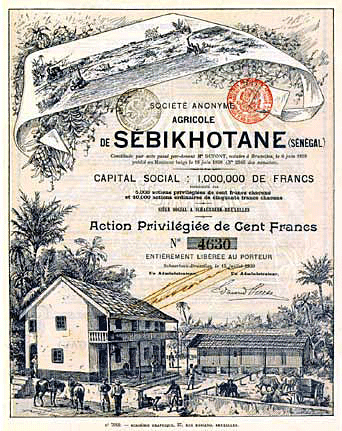 Stocks
represent partial ownership in a company. Today, most companies keep
records of ownership electronically but some allow their shareholders to
request a paper version. Each certificate starts out as a standard
design to which the company adds the date of issue, identification
number, and other information, including the printed signature of the
chief executive. Executives on older certificates signed them in ink. Stocks
represent partial ownership in a company. Today, most companies keep
records of ownership electronically but some allow their shareholders to
request a paper version. Each certificate starts out as a standard
design to which the company adds the date of issue, identification
number, and other information, including the printed signature of the
chief executive. Executives on older certificates signed them in ink.
According to financial historians, partnership agreements dividing
ownership into shares began to be used in northern Italy during the
Middle Ages. However, these early shares were only intended to be in
effect for a short time and only included a small group of people.
Eventually the idea of shareholding spread to Belgium, and it’s believed
the concept caught on in the trading town of Bruges. It was here that
the idea of the stock exchange originated.
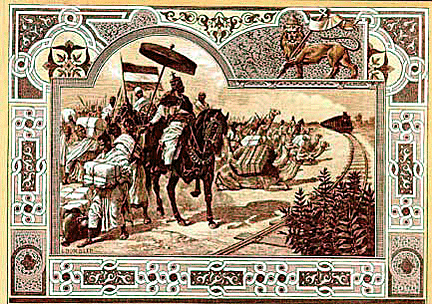 Eventually,
shareholding took its next big step in Amsterdam in the early 17th
century when the Dutch East India Company, formed to encourage trade in
spices from Indonesia, issued shares that were tradable. The company
compensated its shareholders well for their investments. In 1621, the
market saw the issuance of shares for the Dutch West India Company, and
much financial innovation ensued. Stock exchanges in the New World
didn’t appear until 1790 in Philadelphia and then two years later in New
York. Eventually,
shareholding took its next big step in Amsterdam in the early 17th
century when the Dutch East India Company, formed to encourage trade in
spices from Indonesia, issued shares that were tradable. The company
compensated its shareholders well for their investments. In 1621, the
market saw the issuance of shares for the Dutch West India Company, and
much financial innovation ensued. Stock exchanges in the New World
didn’t appear until 1790 in Philadelphia and then two years later in New
York.
Collectors love canceled stock certificates because of their beautiful
and elaborate graphics, as well as their connection to the historically
significant companies they represent.
What Affects the Value of Old Stock
Certificates
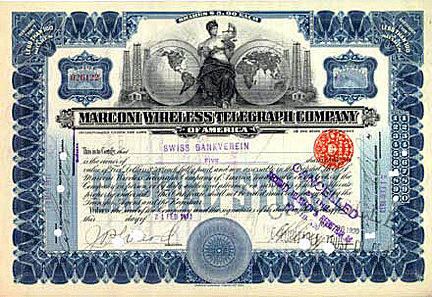 Old
certificate values vary depending on their rarity, beauty, collector
interest, historical importance, and autographs, and industries for
which they’re issued. Like all collectibles, supply and demand determine
value. Interesting pieces create a lot of demand while supplies vary. Old
certificate values vary depending on their rarity, beauty, collector
interest, historical importance, and autographs, and industries for
which they’re issued. Like all collectibles, supply and demand determine
value. Interesting pieces create a lot of demand while supplies vary.
What affects the market for stock certificates? Above all, general
economic conditions tend to influence the prices of old stock
certificates because many collectors of them are also involved in the
real stock market. The law of supply and demand, as with other
collectibles, governs this market as well. And Internet auctions have
increased not only the availability of old stock certificates but their
ease of purchase.
What Determines the Pricing of Old Stock
Certificates?
Two important price boosters are signatures of important people and
newly formed companies. For example, a Standard Oil Company certificate
that John D. Rockefeller signed is worth nearly $8,000 today. Prices
have leveled off in the last few years and finding rare certificates at
reasonable prices has become a real challenge.
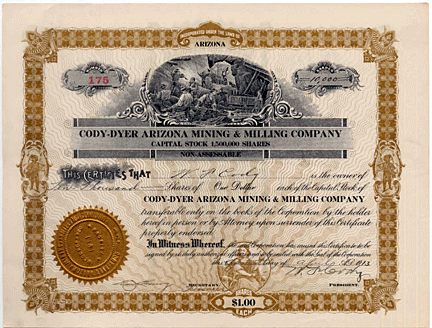 As
with postage stamps, pricing can be affected by the rarity of a
certificate—the rarer it is, the higher the price. An autograph of
someone famous of the stock company with which he was involved also
raises the price. Whether a stock certificate has ever been issued also
influences it value, as does its age and decoration. The location and
history of the company don’t affect the price of a certificate as much
as, say, its condition and whether its cancelled or not. However, no one
point is always in control of a certificate’s value. As
with postage stamps, pricing can be affected by the rarity of a
certificate—the rarer it is, the higher the price. An autograph of
someone famous of the stock company with which he was involved also
raises the price. Whether a stock certificate has ever been issued also
influences it value, as does its age and decoration. The location and
history of the company don’t affect the price of a certificate as much
as, say, its condition and whether its cancelled or not. However, no one
point is always in control of a certificate’s value.
As with any collectible, you should always collect stock certificates
that are in excellent condition, have been issued, and are uncancelled.
You should also collect certificates from industries that you’re
familiar with or in which you’re interested. Early companies issued
their stocks in small quantities, thus limiting the number of their
certificates in today’s market. But there are lots out there for sale at
low to reasonable prices.
<
Back to Readers Ask Archives
Next Article > |
